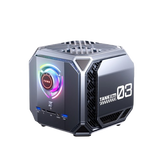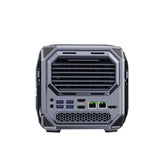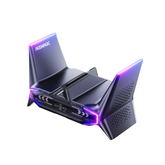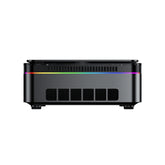Mini PC vs All-in-One (AiO) PC: Which One Is Right for You?

Mini PCs and AiO computers are two popular computing solutions that cater to different user needs and preferences. While both offer a compact and space-saving design, they differ in terms of upgradability, portability, cost, and convenience. Before making a purchasing decision, it is crucial to understand the key differences between Mini PCs and All-in-One computers, as it allows you to choose the option that best aligns with your specific requirements, budget, and intended use case.
What is a Mini PC?
A Mini PC is a compact, small form factor computer that offers the functionality of a full-sized desktop computer in a much smaller package. These systems are designed to save space while still providing sufficient performance for everyday computing tasks, media consumption, and even light gaming.

key features of Mini PCs
- Compact size: Mini PCs typically measure less than 5 inches square and 2 inches tall, making them significantly smaller than traditional desktop towers.
- Powerful hardware: Despite their small size, Mini PCs can pack powerful processors, ample RAM, and fast storage options to handle a wide range of tasks.
- Versatile connectivity: Mini PCs often include a variety of ports, such as USB, HDMI, DisplayPort, and Ethernet, allowing for easy connection to peripherals and networks.
- Quiet operation: With efficient cooling solutions and low-power components, Mini PCs operate quietly, making them suitable for noise-sensitive environments.
Advantages of Mini PCs
- Space-saving design: The compact size of Mini PCs frees up valuable desk space and allows for discreet placement in homes, offices, and other settings.
- Upgradability: Many Mini PCs offer user-upgradable RAM and storage, allowing for future performance enhancements and extended longevity.
- Affordability: Mini PCs often cost less than similarly-specced desktop computers, making them an attractive option for budget-conscious users.
- Flexibility: With their small size and VESA mount compatibility, Mini PCs can be easily integrated into various setups, such as home theater systems, digital signage, or multi-monitor workstations.
What is an All-in-One (AiO) Computer?
An All-in-One (AiO) computer is a desktop computer that integrates all the components, including the display, into a single, streamlined unit. AiO computers offer a sleek, clutter-free design that combines the monitor and computer, eliminating the need for separate components and cables.

Pros and Cons of AiO PC
All-in-One (AiO) computers offer four main advantages: minimal wiring, space-saving compact design, higher integration, and a sleek, modern appearance.
- Sleek and modern aesthetics: The all-in-one design of AiO computers offers a stylish and modern look that complements any workspace or home environment.
- Space-saving solution: By combining the display and computer components into a single unit, AiO computers significantly reduce the footprint required, making them ideal for small offices, apartments, or minimalist workspaces.
- Simplicity and ease of setup: With fewer cables and components to manage, AiO computers are easy to set up and maintain, making them an attractive option for users who prioritize simplicity and convenience.
- Reduced cable clutter: The integrated design and wireless peripherals of AiO computers minimize cable clutter, creating a clean and organized workspace.
As a middle ground between desktop and laptop computers, AiOs excel in combining the best of both worlds. Compared to desktops, AiOs boast higher integration, easier cable management, and a smaller footprint, which is crucial for space-constrained workspaces. In contrast to laptops, AiOs feature larger, higher-quality displays and better performance, resulting in an enhanced working experience.
However, AiOs also have notable drawbacks. Firstly, their highly integrated design compromises upgradability, making it difficult to install additional memory or SSDs, while the processor and graphics card are non-replaceable. Secondly, high-end AiOs are significantly more expensive than similarly-specced desktops and Mini PCs. They offer lower value for money compared to desktops and lack the portability and expandability of Mini PCs, which ultimately limits their market potential.
Mini PC vs AiO Upgradability and Customization
Mini PC Upgradability
Mini PCs offer a high degree of upgradability and customization. Their modular design allows users to effortlessly access and upgrade various components, such as RAM, storage, and occasionally the processor. This, in turn, provides a significant benefit to users who wish to augment their system's performance over time. Classic Mini PCs such as Acemagic AMR5 Mini PC.
Many Mini PCs also present a broad spectrum of configuration options, enabling users to adjust the system to meet their specific requirements. This might involve selecting an appropriate processor, RAM, storage, and graphics card to best fit their needs and budget. Importantly, most Mini PCs use standard desktop components, like SO-DIMM RAM modules and 2.5-inch SSDs or HDDs. Hence, locating compatible upgrades and replacements becomes straightforward. This upgradability ensures users can keep up with the latest hardware advancements, thereby extending the lifespan of their Mini PC investment.
All-in-One (AiO) PC Upgradability
All-in-One (AiO) computers have their limitations in terms of upgradability compared to their Mini PC counterparts. Owing to their integrated design, most components such as the processor and graphics card are soldered to the motherboard, which makes upgrades difficult, if not impossible.
Certain AiO computers, however, do provide the option to upgrade the RAM and storage, albeit the process is generally more intricate than with Mini PCs. Therefore, users are advised to check the specific model's upgradeability before settling on a purchase. Besides, AiO computers regularly feature an array of configuration options at the time of purchase, including varying processors, RAM, storage, and other features.
However, post-purchase customization is largely limited. Even the monitor, which is embedded within the AiO computer, cannot be upgraded separately. Users needing a larger or better-resolution display in the future may have to replace the entire AiO computer.
As such, in comparison, Mini PCs clearly overshadow AiO computers in terms of upgradability and customization. Thanks to their modular design and compatibility with standard components, Mini PCs are better suited for users who value the ability to upgrade and customize their systems over time, while AiO computers might appeal more to those prioritizing initial purchase specifications over future hardware flexibility and upgrades.
Mini PC vs AiO Display and Portability
Mini PC
Mini PCs provide flexible display options, as they do not come with an integrated display. This flexibility allows users to select a monitor that precisely fits their needs, allowing them to choose the screen size, resolution, and panel type, such as IPS or OLED, according to their preferences and budget.
Many Mini PCs also boast robust graphics capabilities and multiple video outputs, like HDMI and DisplayPort, making it straightforward to connect multiple monitors for increased productivity or immersive gaming sessions. In addition to these attributes, Mini PCs are highly portable due to their compact and lightweight design, thus making them extremely suitable for users needing powerful computing capabilities on the move. This portability is further complemented by their versatile placement options, with their small footprints allowing them to be used in a variety of settings, from being mounted behind a monitor via a VESA mount to being attached at the back of a TV for a home theater setup.
All-in-One (AiO) Computers
On the other hand, All-in-One (AiO) computers feature an integrated display, which offers a sleek and space-saving design that concatenates the computer and monitor into a single unit. This amalgamation eliminates the need for a separate monitor purchase and helps reduce cable clutter.
AiOs are available in a range of screen sizes, typically from 21 to 34 inches, and offer multiple resolution options, including Full HD (1920x1080), QHD (2560x1440), and 4K (3840x2160), thus catering to various user requirements. Some AiOs even feature touch screen displays, which provide an intuitive and interactive user experience, potentially enhancing productivity and creativity for certain applications.
However, due to their all-in-one design and larger size compared to Mini PCs, AiOs are generally less portable. While some models are designed to be somewhat thin and lightweight, they are often more cumbersome to move around than Mini PCs.
When it comes to display options and portability, both Mini PCs and AiOs hold unique advantages to consider. Mini PCs enable flexibility in choosing the display and easy portability, while AiOs offer a streamlined, integrated design with a built-in display, reducing the need for additional components and saving desk space.
Mini PC vs AiO Energy Efficiency
Mini PC Energy Efficiency
Due to their smaller size and more efficient components, Mini PCs have lower power consumption compared to All-in-One (AiO) computers. This can reduce electricity costs and lessen the impact on the environment. Given the customizability of Mini PCs, they can opt for more energy-efficient components, such as low-power processors, Solid State Drives (SSDs), and lower power consumption external displays, further reducing the power usage of Mini PCs.
AiO Energy Efficiency
In terms of power consumption, All-in-One (AiO) computers typically require more due to their larger design and built-in display. However, certain models are specifically engineered with energy efficiency as a priority, integrating components designed to maintain low power consumption. To ensure better power management, users can consider choosing AiO devices that come with Energy Star certifications or other similar eco-friendly labels.
In addition to hardware considerations, many AiOs are equipped with firmware power management features. These may include capabilities such as automatic screen dimming and sleep mode, which help to reduce power consumption when the computer is idle or not in active use, thus contributing to overall energy conservation.
Mini PC vs AiO Lifespan
The ability to easily upgrade components in Mini PCs can significantly extend their lifespan. As technology advances, users can replace outdated components with newer, more powerful ones, keeping their system up-to-date and prolonging its usefulness. If a specific component fails, such as the RAM or storage, users can easily replace the faulty part in a Mini PC without needing to replace the entire system, thus extending the overall lifespan.
The integrated design of AiO computers makes it challenging to upgrade components, which can limit their lifespan. As technology progresses, users may find their AiO computer becoming outdated more quickly than a Mini PC with upgradable components. If a critical component in an AiO computer fails, such as the motherboard or display, users may need to replace the entire unit, as these components are often not user-serviceable. This can lead to a shorter lifespan compared to Mini PCs, where individual components can be replaced as needed.
Mini PC vs All-in-One (AiO) Cost
Since Mini PC lacks a monitor, you should consider the price of Mini PC and monitor when comparing AiO. Mini PC and monitor are usually more affordable than AiO. The host and monitor of this solution are separate, and you can choose the accessories that suit your budget, so as to better control the cost, and even if there is a failure, the host and monitor will not fall off together.
In addition, we also need to consider any potential long-term costs, such as upgrades or replacements. Mini PCs have the advantage of being easier to upgrade and DIY, which can save you money in the long run if you plan to update components such as RAM, storage or graphics cards.
Mini PC vs AiO: Which is Better and How to Choose?
Mini PCs excel in terms of upgradability, customization, and performance. Their modular design allows users to easily upgrade components, tailor their system to their specific needs, and keep up with the latest hardware advancements. This makes them an ideal choice for users who prioritize future-proofing, have specific hardware requirements, or engage in demanding tasks such as gaming or content creation.
On the other hand, AiO computers provide a simple, all-in-one solution with a built-in display and a streamlined appearance. They are well-suited for users who value simplicity, aesthetics, and a clutter-free workspace. While AiOs may have limited upgradability compared to Mini PCs, they can still be a great choice for everyday computing tasks and users who don't require extensive customization.
If you are a game enthusiast or a game maniac, it is not recommended to buy an all-in-one computer. After all, the performance is still quite different from that of a mini computer of the same price. If you want beauty, convenience, space saving, and good after-sales service, you can consider an all-in-one computer.
Conclusion
There is no perfect product in this world, only products that are more suitable for you. Whether you choose a mini PC or an all-in-one PC, the key is to find a PC that meets your practical scenarios and enables you to complete tasks efficiently.
More Videos
Frequently Asked Questions (FAQ)
1. Do All-in-One computers require an additional CPU tower?
No, All-in-One computers do not require an additional CPU tower. They integrate the computer components and display into a single, compact device, eliminating the need for a separate tower. All the necessary hardware, such as the processor, memory, storage, and graphics card, is built into the All-in-One, providing a streamlined, all-in-one solution.
2. What are the differences between a Mini PC and an AiO computer?
Mini PCs and All-in-Ones differ in their design, with Mini PCs being compact, standalone units requiring a separate monitor and offering better upgradability and portability, while AiOs integrate components into a single, less upgradable unit that sacrifices portability for a streamlined design.
3. What advantages do Mini PCs have over AiO computers?
Mini PCs are more upgradable, flexible and portable. Users can extend the life of the device by replacing components and connecting various displays. The Mini PC produced by Acemagic can also be easily put into a pocket.
4. What advantages do AiO computers have over Mini PCs?
All-in-One computers provide a simple, space-saving solution with sleek, modern designs that streamline setup and complement various environments, while eliminating the need for separate components and cables.
Read More:
- Difference Between USB A vs USB C & Which One is Better
- HDMI 2.1 VS DisplayPort 1.4
- Amd Ryzen 5 vs Intel i5: Differences & How to Choose
- HDMI 1.4 vs 2.0: What's the Difference and Which One Should You Choose?
Related articles
- Mini PC vs Stick PC Comparison: How to Choose the Best Portable Device
- Mini PC vs SFF PC: Compact Desktop Computer Comparison
- Enhancing ACEMAGIC AMR5 Mini PC Performance with an External GPU
- Mini PC vs. Traditional Desktop: Which Is Right for You
- Raspberry Pi 5 vs Mini PC: Your Guide to Choosing the Right Device
- Dual NIC vs Single NIC Mini PCs: Is a Dual-NIC Mini PC better?







Leave a comment
Please note, comments need to be approved before they are published.